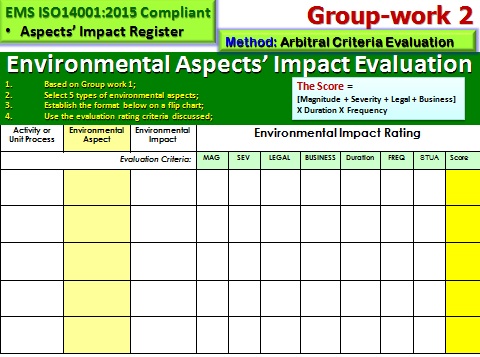ISO 14001 is a globally accepted standard developed by the International Organization for Standardization for the implementation of an environmental management system. ISO 14001 belongs to a family of standards developed for various aspects of environmental management, known as ISO 14000. Along with other standards in the ISO 14000 family, ISO 14001 provides a comprehensive guideline for all areas of EMS, including labeling, performance evaluation, communications and life-cycle analysis.
Determination of environmental aspects is one of the main elements of strategic planning as well as the foundation for an ISO 14001 Environmental Management System (EMS). Maintaining the environmental aspect register. How to develop a risk & opportunities register, do attend the two-day training on ‘ ISO Strategic Approach. In this online course you’ll learn all about ISO 14001, and get the training you need to become certified as an ISO 14001 certification auditor. Environmental aspect identification and classification. It is probably safe to say that the process in question can have significant impact on the environment, and should be noted as such. • ISO 4.3.1 5 Purpose. Having assigned a priority score for each environmental aspect and impact the following. Ref C: Documents and Settings l.platts Desktop EMS Manual & Procedures Aspects & Impacts EMS 01a Environmental Aspects & Impacts Register.doc.
Philosophy
ISO 14001 does not concretely specify acceptable levels of environmental performance; rather, specific environmental issues are addressed in different ISO standards for each business within an industry. ISO 14001 serves to set in place a framework for a more holistic approach to aligning a company's attitude toward environmental policy and its plans and actions so that it can achieve the balance between maintaining profitability and reducing environmental impact.
Background
For modern businesses, conforming to environmental standards is a priority amid the backdrop of global pressure on organizations to minimize impact on the environment. As environmental awareness increases, different stakeholder groups -- such as local and national governments, business and trade associations, customers, employees and shareholders -- want organizations to conform to defined environmental standards and to act as good corporate citizens of a respecting community.
Generic Framework
ISO 14001 can be thought of as the generic requirements for an effective EMS. In keeping the standards somewhat open and not laying down actual, numerical measures of environmental performance, organizations of all sizes and engaged in diverse business operations have a common reference for communication with customers, regulatory bodies and other stakeholders. Regardless of an entity's environmental maturity, it can comply with ISO 14001 guidelines by committing to conform to applicable legislation for the particular industry and committing to work for continual improvement. This commitment is what the ISO 14001 provides the framework for.
Certification
The ISO 14001 standard was published in 1996. It is the only standard from the ISO 14000 family against which an organization may be certified for compliance by an external certification body. The guideline covers all environmental aspects which the organization can control and influence. Any organization able to implement and improve an EMS may seek ISO 14001 certification. Organizations must first define its own environmental policies and adhere to the stated policies. In addition, it must comply with environmental laws and regulations for its industry and region as well as demonstrate compliance.

Compliance Steps
Online Training Iso 14001 2015
Along with stating general requirements and environmental policies, ISO 14001 also prescribes a framework for planning the implementation, putting a supervision and correction system in place and proper management review practices. An organization may align its operations to the ISO 14001 framework by identifying the actions that have an effect on the environment and gaining an insight on relevant laws. The organization can then form objectives for improvement and put in place a management program for proper implementation and improvement.
Iso 14001 Training Powerpoint
- Jürgen François/iStock/Getty Images